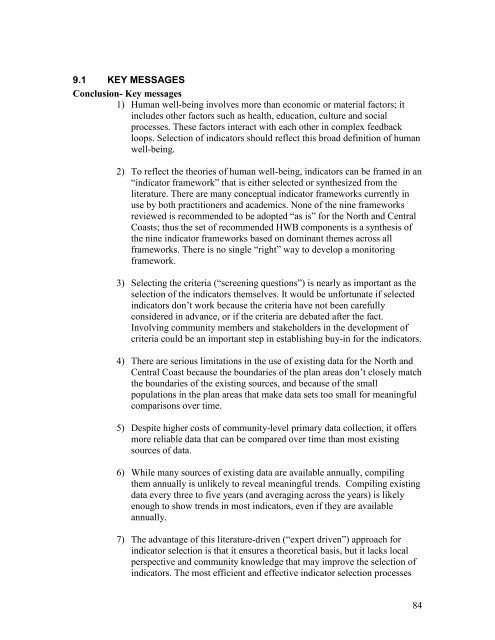Final report - Integrated Land Management Bureau
Final report - Integrated Land Management Bureau
Final report - Integrated Land Management Bureau
Create successful ePaper yourself
Turn your PDF publications into a flip-book with our unique Google optimized e-Paper software.
9.1 KEY MESSAGES<br />
Conclusion- Key messages<br />
1) Human well-being involves more than economic or material factors; it<br />
includes other factors such as health, education, culture and social<br />
processes. These factors interact with each other in complex feedback<br />
loops. Selection of indicators should reflect this broad definition of human<br />
well-being.<br />
2) To reflect the theories of human well-being, indicators can be framed in an<br />
“indicator framework” that is either selected or synthesized from the<br />
literature. There are many conceptual indicator frameworks currently in<br />
use by both practitioners and academics. None of the nine frameworks<br />
reviewed is recommended to be adopted “as is” for the North and Central<br />
Coasts; thus the set of recommended HWB components is a synthesis of<br />
the nine indicator frameworks based on dominant themes across all<br />
frameworks. There is no single “right” way to develop a monitoring<br />
framework.<br />
3) Selecting the criteria (“screening questions”) is nearly as important as the<br />
selection of the indicators themselves. It would be unfortunate if selected<br />
indicators don’t work because the criteria have not been carefully<br />
considered in advance, or if the criteria are debated after the fact.<br />
Involving community members and stakeholders in the development of<br />
criteria could be an important step in establishing buy-in for the indicators.<br />
4) There are serious limitations in the use of existing data for the North and<br />
Central Coast because the boundaries of the plan areas don’t closely match<br />
the boundaries of the existing sources, and because of the small<br />
populations in the plan areas that make data sets too small for meaningful<br />
comparisons over time.<br />
5) Despite higher costs of community-level primary data collection, it offers<br />
more reliable data that can be compared over time than most existing<br />
sources of data.<br />
6) While many sources of existing data are available annually, compiling<br />
them annually is unlikely to reveal meaningful trends. Compiling existing<br />
data every three to five years (and averaging across the years) is likely<br />
enough to show trends in most indicators, even if they are available<br />
annually.<br />
7) The advantage of this literature-driven (“expert driven”) approach for<br />
indicator selection is that it ensures a theoretical basis, but it lacks local<br />
perspective and community knowledge that may improve the selection of<br />
indicators. The most efficient and effective indicator selection processes<br />
84
















